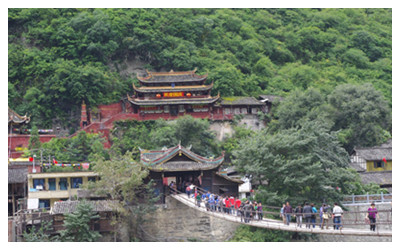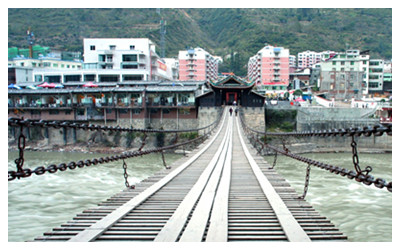Skype: neodalle-travel
Tel: +86 135 7447 2266
E-mail: sales@visitaroundchina.com

Luding Bridge is located in the town of Luding, Sichuan Provicne. For the uninitiated, the bridge may not stand out on first glance -- some iron chains stretched across the gushing Dadu River, with an ornate Qing-style archway on either side. But the battle at Luding Bridge is one of the most famous events in the history of the Red Army's Long March, retold in countless Chinese films, and a legendary tale most Chinese kids grow up with.
Battle of Luding Bridge
 In 1935, a unit of Red Army troops was running away from the Kuomintang and found themselves at the banks of the Dadu river. There weren't enough boats to cross it, so the bridge was their only choice. The Luding bridge, at the time, consisted of 13 chains, nine forming the floor and covered with wooden planks, and four forming handrails. When the Red Army reached the bridge, they found that Kuomintang troops at the opposite end of the bridge had removed two-thirds of the planks and set fire to the rest.
In 1935, a unit of Red Army troops was running away from the Kuomintang and found themselves at the banks of the Dadu river. There weren't enough boats to cross it, so the bridge was their only choice. The Luding bridge, at the time, consisted of 13 chains, nine forming the floor and covered with wooden planks, and four forming handrails. When the Red Army reached the bridge, they found that Kuomintang troops at the opposite end of the bridge had removed two-thirds of the planks and set fire to the rest.
A unit of 22 men was ordered to cross the bridge. They abandoned all their equipment except for rifles and bullets, some with grenades between their teeth. They pulled themselves across the chains, dodging enemy fire, and drove away the Kuomintang on the other side. 18 of the 22 survived. Mao Zedong later told Edgar Snow, author of Red Star Over China, that crossing the Dadu River was the most important event of the Long March.
 As with any historical event, there is debate about what precisely happened at Luding Bridge. Some scholars, including Sun Shuyun (in her book The Long March), Jon Halliday and Jung Chang (in their book Mao: the Unknown Story) and Jonathan Clements (in his book Mao Zedong), have questioned how difficult the crossing really was, how many people survived, or if indeed the fight actually occurred at that site or in another town down river. Whatever the viewpoint, the evidence is shaky and based on the accounts of a few eyewitnesses, almost all of whom have now passed away.
As with any historical event, there is debate about what precisely happened at Luding Bridge. Some scholars, including Sun Shuyun (in her book The Long March), Jon Halliday and Jung Chang (in their book Mao: the Unknown Story) and Jonathan Clements (in his book Mao Zedong), have questioned how difficult the crossing really was, how many people survived, or if indeed the fight actually occurred at that site or in another town down river. Whatever the viewpoint, the evidence is shaky and based on the accounts of a few eyewitnesses, almost all of whom have now passed away.
Tours to Luding Bridge
And whatever debate may exist, Luding Bridge is a huge point of pride for locals and tourists alike. We didn't see any tourists ourselves today, as the bridge is currently undergoing repairs, but our guide said Luding  Bridge sees 70-80,000 visitors per year. Business owners on the surrounding street said the tourists bring them needed cash, and a lot of the locals we interviewed beamed with pride when talking about the battle at Luding Bridge.
Bridge sees 70-80,000 visitors per year. Business owners on the surrounding street said the tourists bring them needed cash, and a lot of the locals we interviewed beamed with pride when talking about the battle at Luding Bridge.
Beyond its Long March fame, the bridge is a historical site in its own right. It was built in 1706 and was an important crossing on the Tea and Horse Caravan Trail; this was the main route connecting Sichuan and Tibet. This morning the Qing-style archways were covered in scaffolding and guys in hard hats, but we still got a good look at the three-tiered tile roof and the brightly painted dragons and phoenixes standing on top. And of course, those 13 iron chains stretching across the rumbling muddy waters of the Dadu River.
Travel Tips
Add: Ludqiao Town, Luding County,Sichuan Province
Entrance Fee: CNY 20
Opening hours: 08:00-18:00
 Ask Questions ?
Ask Questions ?